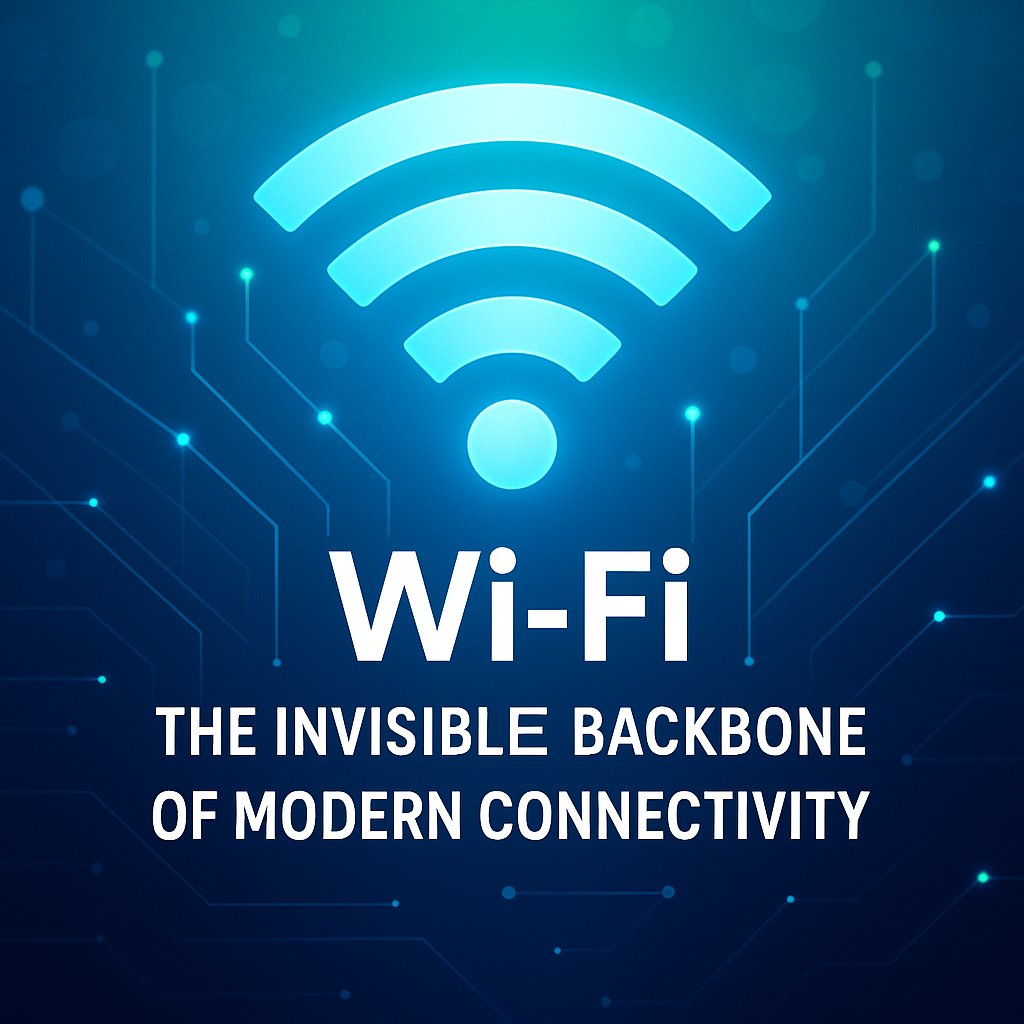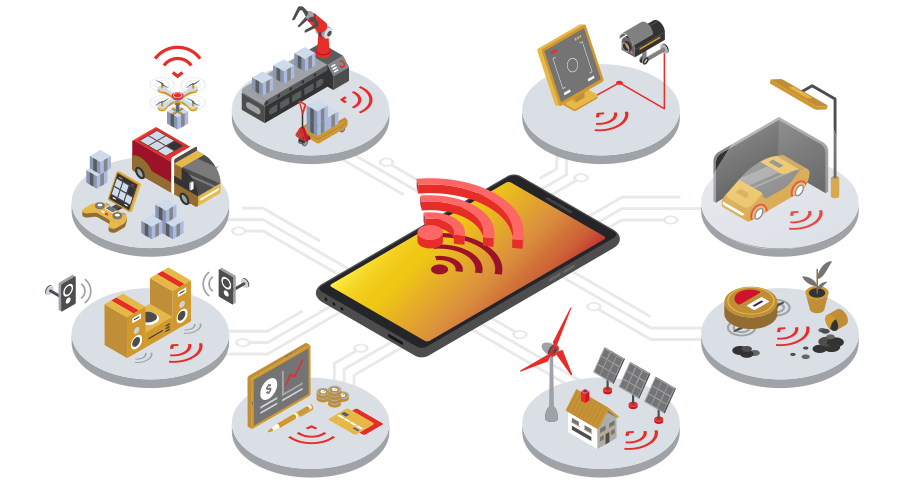Your cart is currently empty!

Wi-Fi: The Invisible Backbone of Modern Connectivity
Introduction: The Wireless Revolution In 1997, when the IEEE released the 802.11 protocol, few predicted that this wireless networking standard—later branded “Wi-Fi”—would become the lifeblood of the digital age. Today, Wi-Fi carries over 60% of global internet traffic, enabling everything from remote surgeries to Mars rover communications. Consider this: During the 2021 Tokyo Olympics, Wi-Fi 6 networks…
Introduction: The Wireless Revolution
In 1997, when the IEEE released the 802.11 protocol, few predicted that this wireless networking standard—later branded “Wi-Fi”—would become the lifeblood of the digital age. Today, Wi-Fi carries over 60% of global internet traffic, enabling everything from remote surgeries to Mars rover communications. Consider this: During the 2021 Tokyo Olympics, Wi-Fi 6 networks handled 194 terabytes of data daily across stadiums, showcasing its scalability. Yet, with great power comes great vulnerability. In 2023, a single misconfigured Wi-Fi router in a Las Vegas casino allowed hackers to steal data from 50,000 guests. This duality of opportunity and risk defines the Wi-Fi landscape.
This guide will:
- Demystify Wi-Fi’s core technologies and applications.
- Equip you with actionable security protocols.
- Explore future trends like Wi-Fi 7 and AI-driven networks.
Table of Contents
1. How Wi-Fi Works: Beyond the Magic
Wi-Fi transmits data via radio waves (2.4 GHz, 5 GHz, or 6 GHz bands) using OFDM (Orthogonal Frequency Division Multiplexing), which splits signals into smaller sub-carriers to avoid interference.
Real-World Example:
When you stream Netflix on a Wi-Fi 6 router:
- Your router uses OFDMA to allocate sub-channels to your TV, phone, and laptop.
- Beamforming directs signals toward your devices, not the neighbor’s house.
- MU-MIMO lets the router communicate with all devices simultaneously, preventing buffering.
Common Myth: “More bars mean faster speeds.”
Reality: Signal strength ≠ bandwidth. A 5 GHz connection with 2 bars often outperforms a congested 2.4 GHz with full bars.
2. Applications: Wi-Fi’s Ubiquitous Reach
Wi-Fi’s versatility spans industries:

a. Healthcare: Saving Lives Wirelessly
- Case Study: At Johns Hopkins Hospital, Wi-Fi 6E-enabled augmented reality (AR) glasses allow surgeons to overlay MRI data in real time during operations.
- IoT Impact: Wearables like the Dexcom G7 glucose monitor transmit patient data to nurses via hospital Wi-Fi, reducing manual checks by 70%.
b. Smart Cities: The Connected Urban Fabric
Barcelona’s “Superblocks” project uses Wi-Fi HaLow to:
- Monitor air quality across 1,000+ low-power sensors.
- Manage smart streetlights that adjust brightness based on pedestrian traffic.
c. Gaming & Entertainment
Wi-Fi 6’s ≤10 ms latency enables cloud gaming (e.g., Xbox Cloud Gaming). During the 2023 Fortnite Global Championship, players on Wi-Fi 6E reported 0% packet loss versus 15% on Wi-Fi 5.
3. Current Wi-Fi Standards: A Technical Breakdown
(Expanded Comparison Table with Use Cases)
| Standard | Max Speed | Key Feature | Best For | Limitations |
|---|---|---|---|---|
| Wi-Fi 4 (n) | 600 Mbps | MIMO (Multi-User Input) | Basic browsing, small homes | Congestion in dense areas |
| Wi-Fi 5 (ac) | 3.5 Gbps | 160 MHz channels | 4K streaming, online gaming | No 2.4 GHz support |
| Wi-Fi 6 (ax) | 9.6 Gbps | OFDMA, TWT | Smart homes, offices with 50+ devices | Limited 6 GHz adoption |
| Wi-Fi 6E | 9.6 Gbps | 6 GHz band (1200 MHz spectrum) | VR/AR, stadiums, manufacturing plants | Short range at 6 GHz |
Pro Tip: For a 3,000 sq. ft. home, deploy a tri-band mesh system (one 2.4 GHz + two 5 GHz nodes) to eliminate dead zones.
4. Wi-Fi Security: A Hacker’s Playground
a. Encryption Evolution: From WEP to WPA3
- WEP’s Fatal Flaw: In 2005, the FBI cracked a WEP-protected network in 3 minutes using AirSnort.
- WPA3’s SAE: Uses Dragonfly Key Exchange to prevent offline password cracking.
Step-by-Step: Securing Your Home Network
- Change Default Credentials: 23% of breaches start with default router passwords (Verizon DBIR 2023).
- Enable WPA3: If unavailable, use WPA2 with AES.
- Disable WPS: This “convenient” button is vulnerable to PIN brute-forcing.
- Create a Guest Network: Isolate IoT devices (e.g., smart fridges) from primary devices.
b. Real-World Attack: The Equifax Breach (2017)
Hackers exploited an unpatched Wi-Fi router in a remote office to access 145 million Social Security numbers.
Lesson: Always enable automatic firmware updates.
5. Upcoming Innovations: Wi-Fi 7 and Beyond
a. Wi-Fi 7 (802.11be): The Game-Changer
- Speed: 46 Gbps (enough to download a 4K movie in 4 seconds).
- MLO (Multi-Link Operation): Combine 2.4 GHz, 5 GHz, and 6 GHz bands for failproof connectivity.
- Use Case: Toyota plans Wi-Fi 7-powered autonomous factories where robots coordinate in real time.
b. Wi-Fi HaLow: The Long-Distance Hero
- Farm Automation: John Deere’s 2024 tractors will use HaLow to relay soil data from sensors 1 mile away.
- Disaster Response: HaLow’s 1 km range aids communication in earthquakes when cellular towers fail.
c. AI-Driven Wi-Fi
Cisco’s “Self-Healing Networks” use machine learning to:
- Predict congestion during peak hours.
- Automatically block devices behaving like the Mirai botnet.
6. Wi-Fi Optimization: A Checklist for Professionals
Boost performance with these evidence-based strategies:
| Issue | Diagnosis | Fix |
|---|---|---|
| Slow 4K streaming | Bufferbloat (latency spikes) | Enable Quality of Service (QoS) |
| Zoom calls dropping | Channel overcrowding | Switch to 5 GHz or use a Wi-Fi analyzer app (e.g., NetSpot) |
| Smart lights offline | Weak HaLow signal | Install a range extender or mesh node |
Advanced Tactic: For a home office, dedicate a 5 GHz band to work devices and 2.4 GHz to IoT gadgets.
7. The Dark Side: Wi-Fi’s Health and Privacy Debates
a. Radiation Myths
- Fact: Wi-Fi routers emit non-ionizing radiation (0.1–10 mW), 100x weaker than microwaves. The WHO confirms no proven health risks.
- Scare Story: In 2019, a viral Facebook post falsely linked Wi-Fi to insomnia. Fact-checkers traced it to a 5G conspiracy group.
b. Snooping Risks
- Stingray Devices: Police tools mimicking cell towers can intercept Wi-Fi calls. Use VPNs like WireGuard to encrypt traffic.
- Eavesdropping Demo: At DEF CON 2023, researchers extracted credit card details from a coffee shop’s Wi-Fi in 11 seconds.
8. The Future: Wi-Fi in 2030
6G Integration: Seamless handoffs between Wi-Fi 7 and 6G cellular.
- Wi-Fi as a Service (WaaS): Companies like Comcast will offer “Wi-Fi performance SLAs” for enterprises.
- Neuromorphic Routers: Brain-inspired chips that optimize traffic without human input.
Conclusion: Becoming a Wi-Fi Guardian
Wi-Fi is a double-edged sword—it enables global progress but demands vigilance. To harness its power:
- Educate: Teach family members about phishing scams over public Wi-Fi.
- Upgrade: Replace routers older than 4 years (they likely lack WPA3).
- Audit: Use tools like Nmap to scan for rogue devices monthly.
As Wi-Fi 7 reshapes industries, remember: The safest network isn’t the one with the latest tech—it’s the one managed by an informed user.
Additional Resources:
Certifications: CWNP (Certified Wireless Network Professional)
Wi-Fi Analyzer Tools: NetSpot, Acrylic Wi-Fi
Security Audits: NirSoft’s Wireless Network Watcher
FAQ
What’s the difference between Wi-Fi and the internet?
Wi-Fi is a wireless method to connect devices to a local network, while the internet is the global network of servers and data. Wi-Fi is like a bridge; the internet is the destination.
Why does my Wi-Fi slow down at night?
This is often due to network congestion (e.g., neighbors streaming Netflix) or ISP throttling. Switch to a less crowded 5 GHz or 6 GHz band, or use QoS settings to prioritize critical devices.
Can Wi-Fi pass through walls?
Yes, but materials matter:
2.4 GHz: Penetrates walls well but has slower speeds.
5/6 GHz: Faster but struggles with thick concrete. Use a mesh system for multi-story homes.
Is public Wi-Fi safe?
No—public networks are hunting grounds for hackers. Always:
Use a VPN (e.g., NordVPN, ProtonVPN).
Avoid accessing banks or sensitive accounts.
Enable “HTTPS Everywhere” in your browser.
How do I know if someone’s hacking my Wi-Fi?
Red flags include:
Unknown devices in your router’s admin panel.
Sudden speed drops.
Router lights flashing when no devices are active.
Tools: Use Fing or GlassWire to scan your network.
Should I hide my SSID?
Hiding your network name offers false security. Skilled hackers can still detect it. Focus on enabling WPA3 and using a strong password instead.
Why does my Wi-Fi disconnect randomly?
Common culprits:
Interference from microwaves or Bluetooth devices.
Outdated router firmware (update via admin settings).
Overheating routers (place in a ventilated area).
How can I boost Wi-Fi signal without a new router?
Try these free fixes:
Reposition your router centrally and elevated.
Change channels using Wi-Fi Analyzer (avoid crowded ones).
Replace old Ethernet cables (Cat 6+ recommended).
What’s the ideal Wi-Fi speed for gaming?
Minimum: 25 Mbps download, 3 Mbps upload.
Competitive gaming: Aim for ≤20 ms latency (use Ethernet for consistency).
When will Wi-Fi 7 devices be available?
Consumer routers like the *TP-Link Archer BE800* launched in late 2023. Mainstream adoption will peak in 2025–2026.
Will Wi-Fi replace cellular data?
Not entirely. Wi-Fi excels in fixed locations (homes/offices), while 5G/6G is better for mobility. Hybrid “Wi-Fi Calling” bridges the gap.
Does aluminum foil really boost signal?
Partially true! A DIY reflector behind your router can direct signals—but gains are minimal (10–15%). Invest in a high-gain antenna instead.
Is Wi-Fi harmful to health?
No conclusive evidence exists. Wi-Fi uses non-ionizing radiation (like FM radio), which lacks energy to damage DNA. The WHO classifies it as “Group 2B” (possibly carcinogenic), the same as pickled vegetables.


